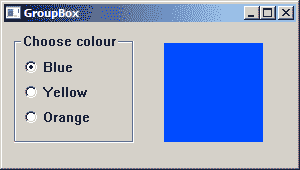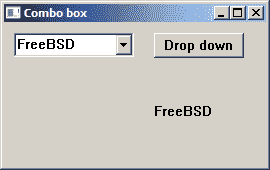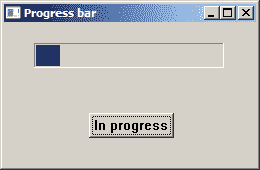Windows API 控件 III
在本章中,我们将结束有关 Windows API 控件的讨论。 我们将提到单选按钮,单选框,组合框和进度条。
RadioButton和分组框
在这里,我们介绍两个控件。分组框是围绕一组控件的矩形。 这些通常是单选按钮。 分组框具有描述控件的标签。 此控件的目的是对某种程度上相关的控件进行分组。单选按钮是一种特殊的按钮,用户可以选择但不能清除。 它允许用户从一组选项中选择一个独占选项。
radio_buttons.c
#include <windows.h>
#define ID_BLUE 1
#define ID_YELLOW 2
#define ID_ORANGE 3
LRESULT CALLBACK WndProc(HWND, UINT, WPARAM, LPARAM);
HINSTANCE g_hinst;
COLORREF g_color;
int WINAPI wWinMain(HINSTANCE hInstance, HINSTANCE hPrevInstance,
PWSTR lpCmdLine, int nCmdShow) {
HWND hwnd;
MSG msg ;
WNDCLASSW wc = {0};
wc.lpszClassName = L"GroupBox";
wc.hInstance = hInstance;
wc.hbrBackground = GetSysColorBrush(COLOR_3DFACE);
wc.lpfnWndProc = WndProc;
wc.hCursor = LoadCursor(0, IDC_ARROW);
g_hinst = hInstance;
RegisterClassW(&wc);
hwnd = CreateWindowW(wc.lpszClassName, L"GroupBox",
WS_OVERLAPPEDWINDOW | WS_VISIBLE,
100, 100, 300, 170, 0, 0, hInstance, 0);
while (GetMessage(&msg, NULL, 0, 0)) {
DispatchMessage(&msg);
}
return (int) msg.wParam;
}
LRESULT CALLBACK WndProc(HWND hwnd, UINT msg,
WPARAM wParam, LPARAM lParam) {
HDC hdc;
PAINTSTRUCT ps;
HBRUSH hBrush, holdBrush;
HPEN hPen, holdPen;
switch(msg) {
case WM_CREATE:
CreateWindowW(L"Button", L"Choose colour",
WS_CHILD | WS_VISIBLE | BS_GROUPBOX,
10, 10, 120, 110, hwnd, (HMENU) 0, g_hinst, NULL);
CreateWindowW(L"Button", L"Blue",
WS_CHILD | WS_VISIBLE | BS_AUTORADIOBUTTON,
20, 30, 100, 30, hwnd, (HMENU) ID_BLUE , g_hinst, NULL);
CreateWindowW(L"Button", L"Yellow",
WS_CHILD | WS_VISIBLE | BS_AUTORADIOBUTTON,
20, 55, 100, 30, hwnd, (HMENU) ID_YELLOW , g_hinst, NULL);
CreateWindowW(L"Button", L"Orange",
WS_CHILD | WS_VISIBLE | BS_AUTORADIOBUTTON,
20, 80, 100, 30, hwnd, (HMENU) ID_ORANGE , g_hinst, NULL);
break;
case WM_COMMAND:
if (HIWORD(wParam) == BN_CLICKED) {
switch (LOWORD(wParam)) {
case ID_BLUE:
g_color = RGB(0, 76, 255);
break;
case ID_YELLOW:
g_color = RGB(255, 255, 0);
break;
case ID_ORANGE:
g_color = RGB(255, 123, 0);
break;
}
InvalidateRect(hwnd, NULL, TRUE);
}
break;
case WM_PAINT:
hdc = BeginPaint(hwnd, &ps);
hBrush = CreateSolidBrush(g_color);
hPen = CreatePen(PS_NULL, 1, RGB(0, 0, 0));
holdPen = SelectObject(hdc, hPen);
holdBrush = (HBRUSH) SelectObject(hdc, hBrush);
Rectangle(hdc, 160, 20, 260, 120);
SelectObject(hdc, holdBrush);
SelectObject(hdc, holdPen);
DeleteObject(hPen);
DeleteObject(hBrush);
EndPaint(hwnd, &ps);
break;
case WM_DESTROY:
PostQuitMessage(0);
break;
}
return DefWindowProcW(hwnd, msg, wParam, lParam);
}
在我们的示例中,我们有一个带有三个单选按钮的分组框。 通过单击单选按钮,我们为右侧的矩形选择背景色。
CreateWindowW(L"Button", L"Choose colour",
WS_CHILD | WS_VISIBLE | BS_GROUPBOX,
10, 10, 120, 110, hwnd, (HMENU) 0, g_hinst, NULL);
分组框是一种特殊的按BS_GROUPBOX样式创建的按钮。
CreateWindowW(L"Button", L"Blue",
WS_CHILD | WS_VISIBLE | BS_AUTORADIOBUTTON,
20, 30, 100, 30, hwnd, (HMENU) ID_BLUE , g_hinst, NULL);
单选按钮也是BS_AUTORADIOBUTTON样式的特殊按钮。
case ID_BLUE:
g_color = RGB(0, 76, 255);
break;
如果单击单选按钮,则将使用选定的颜色填充全局变量。 此变量用于创建填充矩形的画笔。
InvalidateRect(hwnd, NULL, TRUE);
我们使矩形(在本例中为整个窗口)无效,这将导致重绘客户区。 这将启动WM_PAINT消息。 在WM_PAINT消息期间,我们绘制矩形。 在 GDI 一章中更详细地说明了绘图。

图:GroupBox中的单选按钮
ComboBox
组合框是编辑框或静态文本与列表的组合。 当我们需要从可用选项列表中选择一个项目时,将使用一个组合框。
combobox.c
#include <windows.h>
LRESULT CALLBACK WndProc(HWND, UINT, WPARAM, LPARAM);
HINSTANCE g_hinst;
int WINAPI wWinMain(HINSTANCE hInstance, HINSTANCE hPrevInstance,
PWSTR lpCmdLine, int nCmdShow) {
HWND hwnd;
MSG msg ;
WNDCLASSW wc = {0};
wc.lpszClassName = L"Application";
wc.hInstance = hInstance ;
wc.hbrBackground = GetSysColorBrush(COLOR_3DFACE);
wc.lpfnWndProc = WndProc ;
wc.hCursor = LoadCursor(0,IDC_ARROW);
g_hinst = hInstance;
RegisterClassW(&wc);
hwnd = CreateWindowW(wc.lpszClassName, L"Combo box",
WS_OVERLAPPEDWINDOW | WS_VISIBLE,
100, 100, 270, 170, 0, 0, hInstance, 0);
while (GetMessage(&msg, NULL, 0, 0)) {
DispatchMessage(&msg);
}
return (int) msg.wParam;
}
LRESULT CALLBACK WndProc(HWND hwnd, UINT msg,
WPARAM wParam, LPARAM lParam) {
static HWND hwndCombo, hwndStatic;
const wchar_t *items[] = { L"FreeBSD", L"OpenBSD",
L"NetBSD", L"Solaris", L"Arch" };
switch(msg) {
case WM_CREATE:
hwndCombo = CreateWindowW(L"Combobox", NULL,
WS_CHILD | WS_VISIBLE | CBS_DROPDOWN,
10, 10, 120, 110, hwnd, NULL, g_hinst, NULL);
CreateWindowW(L"Button", L"Drop down",
WS_CHILD | WS_VISIBLE,
150, 10, 90, 25, hwnd, (HMENU) 1, g_hinst, NULL);
hwndStatic = CreateWindowW(L"Static", L"",
WS_CHILD | WS_VISIBLE,
150, 80, 90, 25, hwnd, NULL, g_hinst, NULL);
for (int i = 0; i < 4; i++ ) {
SendMessageW(hwndCombo, CB_ADDSTRING, 0, (LPARAM) items[i]);
}
break;
case WM_COMMAND:
if (HIWORD(wParam) == BN_CLICKED) {
SendMessage(hwndCombo, CB_SHOWDROPDOWN, (WPARAM) TRUE, 0);
}
if (HIWORD(wParam) == CBN_SELCHANGE) {
LRESULT sel = SendMessage(hwndCombo, CB_GETCURSEL, 0, 0);
SetWindowTextW(hwndStatic, items[sel]);
}
break;
case WM_DESTROY:
PostQuitMessage(0);
break;
}
return DefWindowProcW(hwnd, msg, wParam, lParam);
}
在我们的示例中,我们在窗口上放置了三个控件:一个组合框,一个按钮和一个静态文本。 静态文本显示组合框中当前选择的项目。 用于演示CBN_SELCHANGE组合框消息。 该按钮以编程方式打开组合框。
hwndCombo = CreateWindowW(L"Combobox", NULL,
WS_CHILD | WS_VISIBLE | CBS_DROPDOWN,
10, 10, 120, 110, hwnd, NULL, g_hinst, NULL);
要创建一个组合框,我们使用L"Combobox"窗口类。 CBS_DROPDOWN标志创建一个下拉列表。
for (int i = 0; i < 4; i++ ) {
SendMessageW(hwndCombo, CB_ADDSTRING, 0, (LPARAM) items[i]);
}
我们用项目填充组合框。 要向组合框添加字符串,我们发送CB_ADDSTRING消息。
if (HIWORD(wParam) == BN_CLICKED) {
SendMessage(hwndCombo, CB_SHOWDROPDOWN, (WPARAM) TRUE, 0);
}
单击该按钮将导致发送CB_SHOWDROPDOWN消息,该消息将以编程方式调用下拉框。
如果从组合框中选择一个项目,则窗口过程将接收WM_COMMAND消息,并在wParam参数的高位字中带有通知消息CBN_SELCHANGE。
if (HIWORD(wParam) == CBN_SELCHANGE) {
LRESULT sel = SendMessage(hwndCombo, CB_GETCURSEL, 0, 0);
SetWindowTextW(hwndStatic, items[sel]);
}
我们找出当前选择的项目。 我们向组合框发送CB_GETCURSEL消息。 该函数返回当前所选项目的索引。 我们将静态文本设置为当前选择的字符串。

图:组合框
进度条
进度条是当我们处理冗长的任务时使用的控件。 它具有动画效果,以便用户知道我们的任务正在进行中。
progressbar.c
#include <windows.h>
#include <commctrl.h>
#define ID_BUTTON 1
#define ID_TIMER 2
LRESULT CALLBACK WndProc(HWND, UINT, WPARAM, LPARAM);
void CreateControls(HWND);
HWND hwndPrgBar;
HWND hbtn;
int WINAPI wWinMain(HINSTANCE hInstance, HINSTANCE hPrevInstance,
PWSTR lpCmdLine, int nCmdShow) {
HWND hwnd;
MSG msg ;
WNDCLASSW wc = {0};
wc.lpszClassName = L"Application";
wc.hInstance = hInstance;
wc.hbrBackground = GetSysColorBrush(COLOR_3DFACE);
wc.lpfnWndProc = WndProc;
wc.hCursor = LoadCursor(0, IDC_ARROW);
RegisterClassW(&wc);
hwnd = CreateWindowW(wc.lpszClassName, L"Progress bar",
WS_OVERLAPPEDWINDOW | WS_VISIBLE,
100, 100, 260, 170, 0, 0, hInstance, 0);
while (GetMessage(&msg, NULL, 0, 0)) {
DispatchMessage(&msg);
}
return (int) msg.wParam;
}
LRESULT CALLBACK WndProc(HWND hwnd, UINT msg,
WPARAM wParam, LPARAM lParam) {
static int i = 0;
switch(msg) {
case WM_CREATE:
CreateControls(hwnd);
break;
case WM_TIMER:
SendMessage(hwndPrgBar, PBM_STEPIT, 0, 0);
i++;
if (i == 150) {
KillTimer(hwnd, ID_TIMER);
SendMessageW(hbtn, WM_SETTEXT, (WPARAM) NULL, (LPARAM) L"Start");
i = 0;
}
break;
case WM_COMMAND:
if (i == 0) {
i = 1;
SendMessage(hwndPrgBar, PBM_SETPOS, 0, 0);
SetTimer(hwnd, ID_TIMER, 5, NULL);
SendMessageW(hbtn, WM_SETTEXT, (WPARAM) NULL, (LPARAM) L"In progress");
}
break;
case WM_DESTROY:
KillTimer(hwnd, ID_TIMER);
PostQuitMessage(0);
break;
}
return DefWindowProcW(hwnd, msg, wParam, lParam);
}
void CreateControls(HWND hwnd) {
INITCOMMONCONTROLSEX icex;
icex.dwSize = sizeof(INITCOMMONCONTROLSEX);
icex.dwICC = ICC_PROGRESS_CLASS;
InitCommonControlsEx(&icex);
hwndPrgBar = CreateWindowEx(0, PROGRESS_CLASS, NULL,
WS_CHILD | WS_VISIBLE | PBS_SMOOTH,
30, 20, 190, 25, hwnd, NULL, NULL, NULL);
hbtn = CreateWindowW(L"Button", L"Start",
WS_CHILD | WS_VISIBLE,
85, 90, 85, 25, hwnd, (HMENU) 1, NULL, NULL);
SendMessage(hwndPrgBar, PBM_SETRANGE, 0, MAKELPARAM(0, 150));
SendMessage(hwndPrgBar, PBM_SETSTEP, 1, 0);
}
在我们的示例中,我们有一个进度条和一个按钮。 该按钮启动一个计时器,该计时器更新进度条。
hwndPrgBar = CreateWindowEx(0, PROGRESS_CLASS, NULL,
WS_CHILD | WS_VISIBLE | PBS_SMOOTH,
30, 20, 190, 25, hwnd, NULL, NULL, NULL);
我们使用PROGRESS_CLASS类名称和PBS_SMOOTH样式创建进度条控件。
SendMessage(hwndPrgBar, PBM_SETRANGE, 0, MAKELPARAM(0, 150));
SendMessage(hwndPrgBar, PBM_SETSTEP, 1, 0);
我们设置进度条的范围及其步骤。
i = 1;
SendMessage(hwndPrgBar, PBM_SETPOS, 0, 0);
SetTimer(hwnd, ID_TIMER, 5, NULL);
当按下开始按钮时,我们将i值设置为 1,设置进度条的初始位置,然后启动计时器。 计时器将定期向窗口过程发送WM_TIMER消息,直到被杀死。
SendMessageW(hbtn, WM_SETTEXT, (WPARAM) NULL, (LPARAM) L"In progress");
当计时器进行时,我们更改按钮的标签。
case WM_TIMER:
SendMessage(hwndPrgBar, PBM_STEPIT, 0, 0);
i++;
if (i == 150) {
KillTimer(hwnd, ID_TIMER);
SendMessageW(hbtn, WM_SETTEXT, (WPARAM) NULL, (LPARAM) L"Start");
i = 0;
}
break;
当我们收到WM_TIMER消息时,我们通过发送PBM_STEPIT消息的一步来更新进度条。 当i变量达到进度条的上限时,计时器将被终止。

图:进度条
在 Windows API 教程的这一部分中,我们已经完成了 Windows 控件的介绍。

